 Image search results - "hotel" Image search results - "hotel" |

Otsu Prince Hotel, the main venue of the 11th Shiga Kenjinkai International Convention held Nov. 12-14, 2007.
|
|

Convention Hall Omi at Otsu Prince Hotel. 第11回滋賀県人会世界大会のメイン会場。
|
|

Entrance to convention hall at Otsu Prince Hotel. Every few years, all the Shiga Kenjinkai in Japan and overseas gather for a convention for a few days.
|
|

Reception counter. The 11th Shiga Kenjinkai International Convention was held in Shiga for the first time in 16 years. There are currently 71 Shiga Kenjinkai groups in Japan and overseas.
|
|

Main venue at the convention hall. A Shiga Kenjinkai is a group or association of people having ties to Shiga Prefecture who now live outside Shiga.
|
|

There is at least one Shiga Kenjinkai in all the prefectures in Japan, and around 15 Shiga Kenjinkai overseas. The hall was lined with banners of many Shiga Kenjinkai from Japan and overseas. Ehime, Brazil, Osaka, etc.
|
|

Toronto, Nagano, Hakodate, Argentina, and Kochi. Outside Japan, there is a Shiga Kenjinkai in Brazil, Peru, Mexico, Canada (Toronto, Vancouver, and Alberta), Argentina, USA (Seattle, California, and Hawaii), Hong Kong, Indonesia, UK, France, and Germany.
|
|

Kita-Kyushu, Southern California (Nanka), and Hiroshima
|
|

Western Canada, Yamaguchi, and Miyagi
|
|

Saitama, Kanagawa, France, Matsumae
|
|
|

Japanese-English interpreting was provided
|
|

Opening ceremony started at 10:30 am on Nov. 13, 2007.
|
|

Otaka Tokio, Chairman of the National Federation of Shiga Kenjinkai, delivers a welcome message. 大高時男
|
|

Dehara Itsuzo, Shiga Prefectural Assembly Chairman
|
|

A representative for Mekata Makoto, Chairman of the Shiga Prefecture City Mayors' Association and also the mayor of Otsu.
|
|

Natsuhara Satoru, Chairman of the Shiga Prefecture Town Mayors' Association and also the mayor of Taga town.
|
|

The Lieutenant Governor of Shiga (substituting for Governor Kada who was hosting the Emperor and Empress visiting Shiga) bestows awards to people who have long contributed to promoting Shiga.
|
|

Chairman Otaka gives letters of appreciation to Shiga Kenjinkai members for meritorious service. In the afternoon, the keynote speech was given by Donald E. Devaney who talked about historical ties between Shiga and the U.S. (photography was not allowed).
|
|

In an adjacent hall was the "Social Salon" with exhibits by most of Shiga's cities and towns and by various Shiga Kenjinkai. Many tourist pamphlets (mostly in Japanese) were provided.
|
|

Hikone's exhibit in the Social Salon, featuring red samurai armor from the Ii clan.
|
|

National high school soccer tournament award from Yasu. (Yasu High School won the national title in Jan. 2006.)
|
|

Exhibit by Takashima city.
|
|
|

Overseas Shiga Kenjinkai exhibits.
|
|

Shiga Kenjinkai from Canada and Mexico.
|
|

Niigata Shiga Kenjinkai exhibit included stuff from Hokuriku region. Web site here.
|
|

Exhibits by other Shiga cities.
|
|

Shiga Prefecture exhibited some plastic fish.
|
|

Biwa masu trout above, and nigorobuna crucian carp (funazushi) on bottom.
|
|

Caffy, official mascot for the Sports Recreation event in 2008.
|
|

Popular Hiko-nyan from Hikone also made an appearance in the Social Salon.
|
|

Hiko-nyan is a helmeted cat, related to the Ii clan.
|
|

On Nov. 13, there was a symposium called "Shiga and Cultural Exchanges."
|
|

One panelist was a priest from Enryakuji temple on Mt. Hiei.
|
|

Near Hie Shrine is (or was) Capital Tokyu Hotel where the Beatles stayed in 1966.
|
|

The Social Salon was a good place to hang out between meetings and symposiums. It also had mini presentations by several overseas Kenjinkai.
|
|

Interesting slide show by the Southern California Shiga Kenjinkai showing their activities.
|
|

A comedian from Mt. Ibuki in Maibara.
|
|

Dinner banquet hosted by Shiga Prefecture on Nov. 13, 2007.
|
|

Governor Kada Yukiko gives a welcome message in both Japanese and English. In Japan, extremely few politicians can do this. Nice that Shiga has a bilingual governor who once studied in the U.S.
|
|

Kanpai!
|
|

Buffet
|
|

Koto entertainment by Maiko, a well-known singer-songwriter from Shiga. 真衣子
|
|

On the morning of Nov. 14, a boat cruise on the Michigan. Narration in both Japanese and English explaining about Lake Biwa's ecology. I was unable to join this cruise, so no photos.
|
|

In the afternoon of Nov. 14 was a "Youth Session," or panel discussion by representatives of various Kenjinkai overseas. They discussed about recruiting younger members and facilitating networking among members.
|
|

Questions from the audience were also taken.
|
|

Social Salon also served green tea and sweets.
|
|
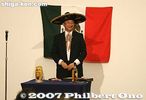
Mini presentation by the Biwako-no-Kai from Mexico.
|
|

Door prizes were given out in a drawing. There were so many prizes donated by various Kenjinkai that it took almost an hour to give them all out.
|
|

Final dinner on Nov. 14, 2007. Some wore happi coats or a kimono.
|
|

For the first hour (6 pm - 7 pm), we suffered through endless speeches by politicians. (Speeches should not be longer than 20 min. total at any event.)
|
|

Speech by Kunimatsu Yoshitsugu, Chairman of the Shiga Intercultural Association for Globalization.
|
|

Kunimatsu Yoshitsugu, Chairman of the Shiga Intercultural Association for Globalization. He is also the former Shiga governor.
|
|

Kanpai!
|
|

Food, finally! All from Shiga. Lots of fish, and funa-zushi too.
|
|

Entertainment started with taiko drumming.
|
|

Governor Kada teaches us how to dance the Goshu Ondo, a native dance of Shiga. She spoke in both Japanese and English again. Also see the video at YouTube.
|
|

Almost everyone got up to dance the goshu ondo. It's like a bon dance peculiar to Shiga. Also see the video at YouTube.
|
|

Goshu ondo
|
|

Members of the Toronto Shiga Kenjinkai dance goshu ondo.
|
|

At the end, we sang Biwako Shuko no Uta (Lake Biwa Rowing Song). The party ended at 9:30 pm.
|
|
|

Entrance to Amami Resort Basyayamamura, a resort hotel and restaurant on the southern shore of the northern part of the island. Short drive from the airport.
|
|
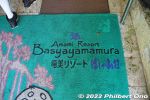
We had lunch here. Address: 鹿児島県奄美市笠利町用安1246-1
|
|
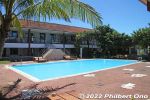
Amami Resort Basyayama-mura pool. Website: basyayama-mura.com
|
|
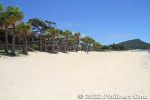
Amami Resort Basyayama-mura restaurant terrace right on the beach..
|
|

Amami Resort Basyayama-mura has a nice, white-sand beach.
|
|
|
|
|
|
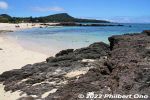
Lava rock outcropping also on the beach.
|
|
|
|
|
|
|
|
|
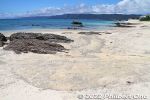
This beach had pumice rocks (軽石) creating artistic patterns on the sand. They were still washing up on the beach in June 2022, but not as much as in Oct. 2021 when they clogged harbors and blanketed beaches.
|
|
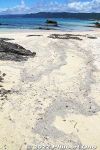
On Amami-Oshima, Kagoshima, Amami Resort Basyayama-mura beach had pumice that came from an undersea volcano (Fukutoku-Okanoba) erupting near the Ogasawara islands (way south of Tokyo).
|
|
|
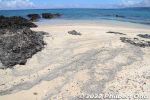
Pumice rocks are small, lightweight, porous pebbles. Floats on water. Saw it for the first time here.
|
|
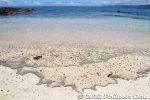
In 2021, an army of volunteers took weeks to clean up Okinawan and Amami beaches. It was almost like cleaning up an oil spill. Glad the problem has subsided.
|
|

Pumice pebbles on a beach in Amami-Oshima, Kagoshima, Japan.
|
|
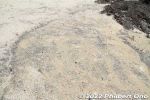
Someone had recently raked or cleaned up the pumice.
|
|

Basha-yamamura restaurant is a great place for lunch. The terrace has ocean views. This is the cheapest dish on the menu, Tonkotsu udon noodles for ¥1,000. 豚骨うどん
|
|

Restaurant lunch menu. Mainly seafood and local cuisine. Open 11 am to 9 pm.
|
|
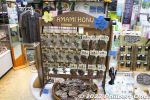
Gift shop
|
|
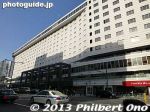
Tokyu Hotel in Akasaka.
|
|
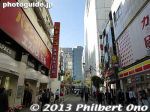
Akasaka
|
|
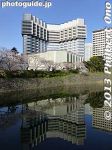
The shrinking hotel. Akasaka Prince Hotel in Tokyo was being demolished from top to bottom. It used to be 39 stories high. Now it's about 10-15 stories in March 2013.
|
|

It's an enclosed demolition system starting at the top. They've kept the building's roof intact while being supported by temporary pillars using hydraulic jacks.Before they started, they first installed cranes and a suspended canopy (seen here) that slides down. This system reduces dust and noise, makes it safer for workers, doesn't affect surrounding buildings, and generates electricity with the crane lowering debris.
|
|
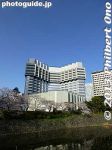
As the top floor is gutted and debris removed by cranes inside the building, they lower the roof, thereby shrinking the building.
|
|
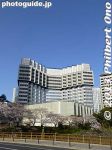
The demolition started in June 2012 and was completed in May 2013. Built in 1982, the Akasaka Prince Hotel is Japan's tallest building ever to be demolished.
|
|
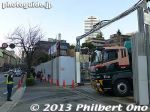
Trucks leave the demolition site.
|
|

View of Imazu from Imazu Sun Bridge Hotel, Imazu's highest building.
|
|

View of Imazu from Imazu Sun Bridge Hotel.
|
|

View of Imazu shore from Imazu Sun Bridge Hotel. 今津サンブリッジホテル
|
|
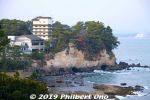
Near Rokkakudo Pavilion on the Izura coast is Itsuura Kanko Hotel (五浦観光ホテル), pictured here on the cliffs. This was our hotel for the night. It had prime views of the coast.The hotel was high enough on the cliff to escape the five-meter-high tsunami on March 11, 2011. The hotel suffered only minor damage from the earthquake. The ground is very solid here, so quake damage was minimal.
Note that the hotel's name is pronounced "Itsuura" while the coast is "Izura." (Kanji characters are the same.) izura.net
|
|
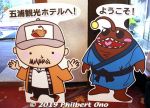
In the hotel lobby: Kita-Ibaraki's official mascots, An-chan and Kou-chan. Together, they are "Ankou" which means "monkfish," or angler fish that is the city's most famous delicacy. An-chan is a fisherman, and Kou-chan is a monkfish.
|
|
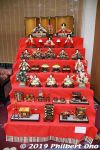
In the hotel lobby, Hina Matsuri dolls displayed for Girl's Day in early March.
|
|
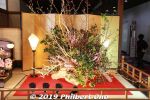
Lovely flowers in the hotel lobby.
|
|
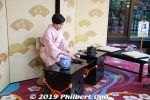
We arrived in the late afternoon in time for a tea ceremony in the hotel lobby. Conducted by the hotel's okami-san (proprietress 女将).
|
|
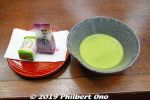
My complimentary matcha tea and confections.
|
|
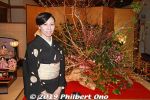
Itsuura Kanko Hotel's okami-san or proprietress (女将) speaks English. The hotel also has English-speaking staff.
|
|
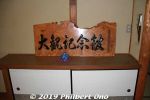
Itsuura Kanko Hotel is quite unique and historical because it renovated the artist residences of Nihonga painters Yokoyama Taikan and Kimura Buzan and uses them as part of the hotel where guests can stay. We actually stayed in the Yokoyama Taikan residence here. (横山大観記念館 特別室)
|
|
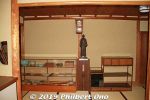
Entrance foyer of Yokoyama Taikan Memorial Hall where we stayed. Great private lodging for groups up to 22 people.
|
|
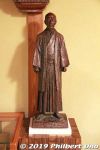
Statue of Yokoyama Taikan (横山大観), a very famous Japanese Nihonga painter. Taikan was born in Mito, the capital of Ibaraki. (横山大観)
|
|
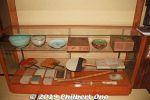
Yokoyama Taikan (1868–1958) is one of the most famous Nihonga painters. His former residence includes a showcase of his artifacts.
|
|
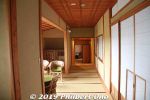
Main corridor inside Yokoyama Taikan Memorial Hall.
|
|
|
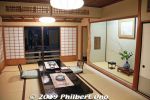
This used to be part of Yokoyama Taikan's living room, now one of the rooms where you can stay.
|
|
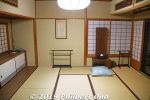
Another room of the living room.
|
|
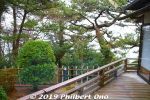
Outside the living room, a moon-viewing deck.
|
|
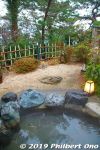
The Taikan house also has a small outdoor hot spring bath.
|
|
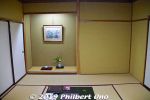
Another part of the Taikan house. Very aesthetic.
|
|
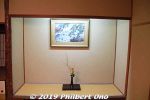
Beautiful tokonoma and painting.
|
|

Taikan's residence is great for groups up to 22 people. It's a residence separate from the main hotel building so there's lots of privacy. Rates are very reasonable too. It was awesome to stay here.
|
|
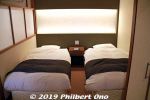
This is a typical room in the hotel's modern tower. Twin beds.
|
|

Typical room in the hotel's modern tower.
|
|
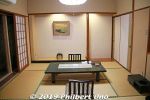
Typical room in the hotel's modern tower. This is the living room.
|
|
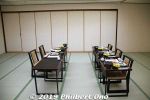
In the modern hotel tower, our banquet room for dinner.
|
|
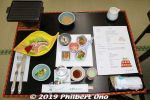
Appetizers for our full-course dinner.
|
|
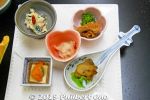
Appetizers.
|
|
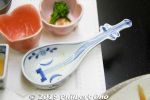
Biwa lute-shaped dish.
|
|
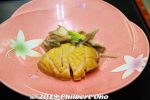
Abalone steak.
|
|
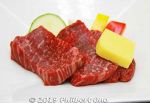
Local Hitachi Wagyu beef. ("Hitachi" is an old name for Ibaraki Prefecture. The famous electronics company Hitachi is also from Ibaraki.) 常陸牛
|
|

Hotel staff in kimono cooking my Hitachi Wagyu beef. 常陸牛
|
|
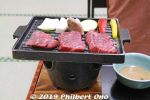
Hitachi Wagyu beef was just a small part of our dinner. We got really stuffed. 常陸牛
|
|
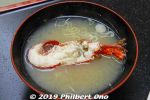
Lobster in miso soup.
|
|

Sushi. Tuna, shrimp, ika squid, hotate scallop.
|
|
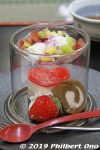
We were super stuffed, but there's always room for dessert...
|
|
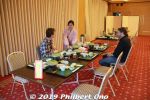
Next morning, breakfast in a large banquet hall.
|
|
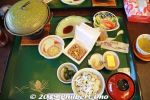
Breakfast included natto fermented soybeans. Ibaraki is famous for natto.
|
|
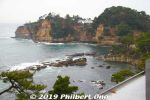
View from the hotel's modern tower.
|
|
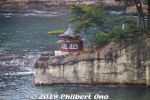
View of Rokkakudo from the hotel's modern tower.
|
|
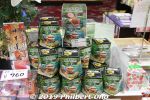
Hotel gift shop.
|
|
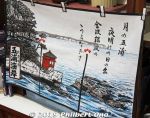
Hotel gift shop had this noren curtain with Rokkakudo design.
|
|
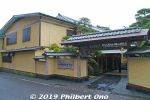
Another part of the Itsuura Kanko Hotel is the main wing (本館) which is the former artist residence of Kimura Buzan (木村武山), another famous Nihonga painter who followed Tenshin to Izura.
|
|
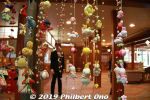
Lobby with Hina Matsuri decorations.
|
|
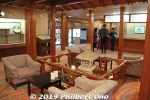
Itsuura Kanko Hotel Honkan lobby.
|
|
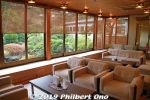
Itsuura Kanko Hotel Honkan lobby.
|
|
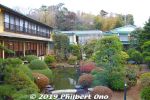
Courtyard garden of Buzan home.
|
|
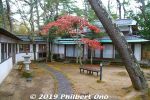
Different parts of the residence are connected by enclosed corridors.
|
|
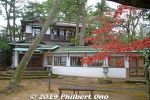
Part of the Buzan residence.
|
|
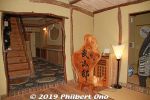
Entrance lobby of Kimura Buzan home. The wooden sign says "Buzan Residence." 武山邸
|
|
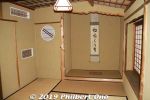
Buzan's beautiful tea ceremony room. Very chic. Available for rent for tea ceremonies.
|
|
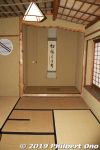
Buzan's beautiful tea ceremony room.
|
|

A large guest room. 武山邸客室
|
|
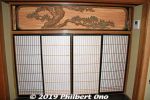
Elegant transom with a pine tree carving.
|
|
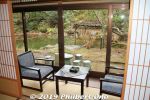
Relax here with a view.
|
|
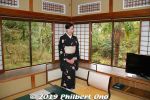
The okami-san posing in another guest room of the Buzan residence.
|
|
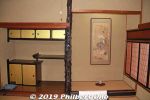
Tokonoma of another guest room. Many of the materials are quite rare and valuable today.
|
|
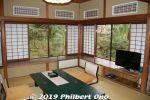
Corner room.
|
|
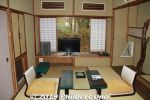
A smaller guest room.
|
|
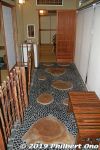
Corridor with pebbled floor leading to the outdoor bath.
|
|

Outdoor bathtub made of Shigaraki-yaki pottery (from Shigaraki, Shiga Prefecture). The hotel has excellent taste in bathtubs. 信楽焼
|
|
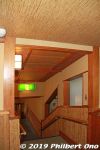
Fancy corridor inside Kimura Buzan home.
|
|
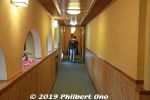
Fancy corridor inside Kimura Buzan home.
|
|
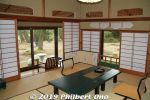
Large and private corner guest room inside Kimura Buzan home. It costs about ¥18,000 per person per night to stay here.
|
|
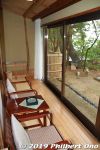
One of the most elegant Japanese-style hotels I've ever seen. Precious artwork everywhere. It's like staying in an art museum.
|
|
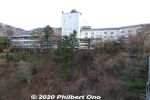
Along Kinugawa River, Kinugawa Park Hotels. It has multiple hotel buildings. I stayed in the Kirakukan tower in the center. 鬼怒川パークホテルズ
|
|
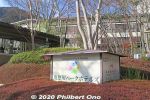
Kinugawa Park Hotels, where we stayed overnight in Kinugawa Onsen hot spring. Very nice hotel. 鬼怒川パークホテルズ
|
|

My nice room at Kinugawa Park Hotels (Kirakukan 9th floor). Ten tatami mats plus twin beds. This room can normally sleep six people or so. 鬼怒川パークホテルズ
|
|
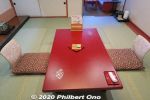
Low table in my room.
|
|
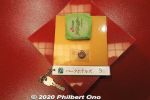
Welcome confection and room key.
|
|

Window-side of the room had twin beds.
|
|

Twin beds in my room. Unless it's a double bed, a futon is always more comfortable.
|
|
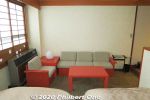
Sofa
|
|
|
|
|
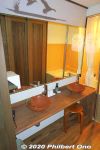
Bathroom.
|
|

Bathroom sink made of pottery.
|
|
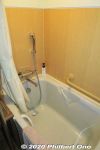
Bathtub.
|
|

Refrigerator with paid drinks.
|
|
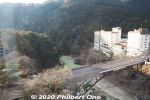
View from my room on the top floor (9th floor).
|
|
|
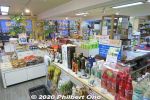
Hotel gift shop.
|
|
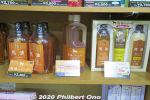
Horse oil products like shampoo.
|
|

Kinugawa Cider
|
|
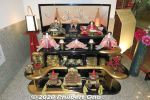
Hina dolls at Kinugawa Park Hotels.
|
|
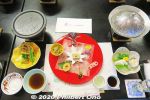
The start of our aesthetic and delicious kaiseki dinner at Kinugawa Park Hotels in Kinugawa Onsen, Nikko. 鬼怒川パークホテルズ
|
|
|
|

Eggplant
|
|
|
|
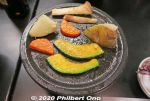
Vegetables
|
|
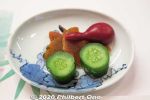
Pickles
|
|
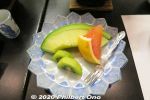
Fruits for dessert.
|
|
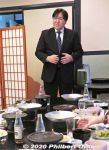
The hotel president also greeted us during dinner and gave us the VIP treatment.
|
|
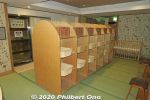
Changing room at the Kinugawa Park Hotels hot spring bath.
|
|
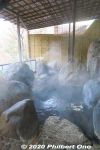
Outdoor hot spring bath at Kinugawa Park Hotels (Kirakukan) in Kinugawa Onsen, in the morning. 鬼怒川パークホテルズ
|
|
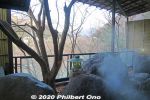
Outdoor hot spring bath at Kinugawa Park Hotels in Kinugawa Onsen.
|
|
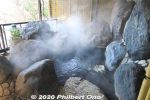
Outdoor hot spring bath at Kinugawa Park Hotels in Kinugawa Onsen.
|
|
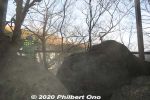
View from the outdoor bath.
|
|
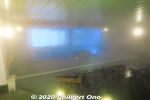
Indoor hot spring bath at Kinugawa Park Hotels in Kinugawa Onsen. Large rectangular bath and round, barrel baths.
|
|

Round, barrel bath.
|
|
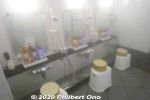
Soaping area.
|
|
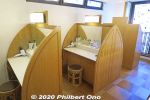
Hair dryers, etc.
|
|
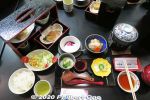
Breakfast at Kinugawa Park Hotels in Kinugawa Onsen, Tochigi.
|
|
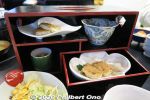
Breakfast at Kinugawa Park Hotels.
|
|
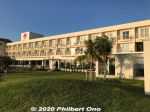
On the southern coast of Ishigaki, we stayed at Ishigakijima Beach Hotel Sunshine for one night. It's a nice hotel. About 30 min. by car from the airport. 本館 https://www.ishigakijima-sunshine.net/
|
|
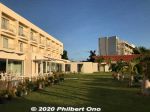
Ishigakijima Beach Hotel Sunshine has the main building on the left. We stayed in the newer annex seen in the distance. Both buildings face the ocean.Including breakfast, it costs ¥8,000/person for two people in a room in the main building.
|
|

Ishigakijima Beach Hotel Sunshine's newer Ocean Garden annex. 新館
|
|
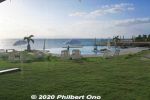
Hotel pool if you want to swim. Because you cannot swim in the ocean...
|
|
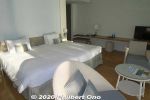
My nice room at Ishigakijima Beach Hotel Sunshine's Ocean Garden annex.
|
|
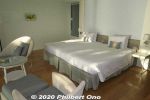
Very modern room.
|
|

Room rate is about ¥15,000/person in this new annex. Pricing also depends on the season.
|
|
|
|
|
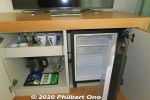
Refrigerator.
|
|

Roomy balcony of my hotel room.
|
|
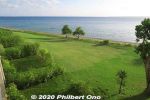
View from my room.
|
|
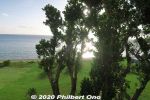
View from my room, partially obstructed by a big tree.
|
|

Tropical plant.
|
|

Although the hotel's name has the word "Beach," there's no beach and it's not for swimming. In summer, they have marine activities, but no ocean swimming or sunbathing on a beach. There's a pool and lawn though.
|
|
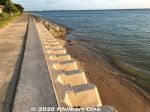
Walked along the oceanfront.
|
|
|
|

An adjacent hotel had chairs on the waterfront for the sunset.
|
|
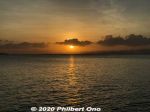
Ishigaki sunset.
|
|
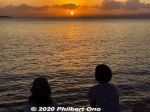
The hotel's oceanfront does have great Ishigaki sunset views.
|
|
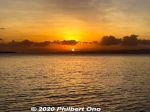
Ishigaki sunset.
|
|
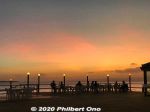
Hotel restaurant terrace at sunset. オープンレストラン 海辺のテラス
|
|
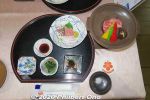
Dinner at the hotel's Nami no Shi (波の詩) restaurant. Dinner was kaiseki ryori (会席料理) including Okinawan beef. 赤瓦レストラン 波の詩にがなの白和え、グルクン南蛮漬、小松菜の胡麻和え、お造り 2 点盛、島魚の煮つけ、県産和牛の 陶板焼き、ゆし豆腐のすまし汁
|
|
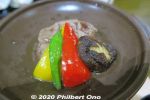
Dinner at the hotel's restaurant.
|
|
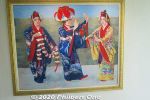
Painting of Okinawan dancers in the hotel.
|
|
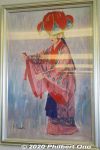
Painting of Okinawan yotsudake dancer in the hotel corridor.
|
|
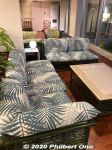
Hotel lobby sofas.
|
|
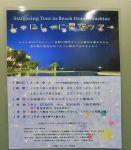
Stargazing on the Ishigakijima Beach Hotel Sunshine's roof. This tour option is called "Shani-shani Hoshizora Tour" (しゃにしゃに星空ツアー). Info in Japanese: https://www.utakuna-ishigakijima.com/hoshizoratour
|
|
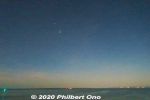
Starry night from Ishigakijima Beach Hotel Sunshine's roof.
|
|

We're lying flat on cots and staring at the sky as our stargazing guide used a laser pointer to point out stars and constellations.
|
|

They also had a telescope to see Saturn and the moon.
|
|
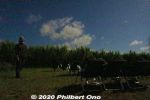
Another stargazing spot on Ishigaki, in the middle of sugar cane. We were with a large group of people also sitting on camping chairs.The guide standing on the left talked nonstop in Japanese with a microphone. He used a laser pointer to point out constellations and stars.
|
|
|
|
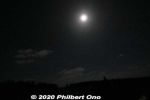
Moon was nice too.
|
|
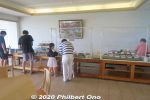
Breakfast buffet at the hotel restaurant in the main building. Plastic partitions protect the food. ブーゲンの浜
|
|
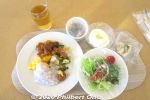
My buffet breakfast at at the hotel restaurant in the main building. Most dishes are covered with Saran wrap.
|
|
|
|